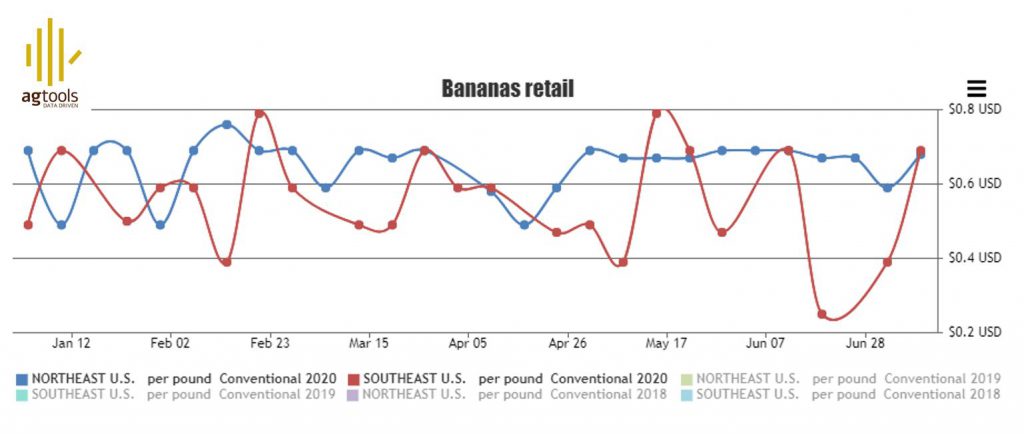
Overall retail pricing for bananas in the U.S. has increased 2 cents per pound in 2020 compared to the year before, but that doesn’t tell the story of wild swings from week to week and from region to region.
“At first glance, it appears that 2020 can’t make up its mind when it comes to settling on a retail range, let alone a price,” said Matt DeBoer, senior vice president of retail sales for Agtools BB #:355102. “2019 stayed between $0.40 and $0.50 with a few exceptions, while 2020 approached $0.60 on the high side and $0.30 on the low, showing the impact of COVID-19 on retail pricing across the nation.”

Blue Book has teamed with Agtools Inc., the data analytic service for the produce industry, to look at a handful of crops and how they’re adjusting in the market during the pandemic.
Overall, DeBoer said, pricing in 2020 is averaging $0.47 cents per pound versus $0.45 per pound last year.
 The market is showing regional trends as well, he said.
The market is showing regional trends as well, he said.

“The Northeast region, with a couple exceptions, is consistently higher than the Southeast,” DeBoer said. “Move to the graph below and 2020 tells a different story. The Southeast region average retail exceeds the Northeast region nine times and reveals a wide variance in the retail price range versus the same period in 2019.”

Ninety percent of bananas in the U.S. come from five countries: Guatemala, Ecuador, Costa Rica, Honduras, and Mexico.

Ecuador is increasing production, and planted an additional 4,000 hectares of bananas last year in order to increase its footprint across the globe.
“Looking at US volume, Ecuador is up 26% through July 16,” DeBoer said. “While their volume may be up, it hasn’t exactly been profitable for growers who are considering stopping their activities,” due to low prices and pressure from the TR4 banana virus.
“While bananas remain a staple item of the produce section, the strain on suppliers is very real,” DeBoer said. “Aside from record low prices in Ecuador, TR4 disease remains a very real threat to the global supply of bananas.”
New varieties are being tested, and greater safety measures are being put into place to protect the current production regions.
Overall retail pricing for bananas in the U.S. has increased 2 cents per pound in 2020 compared to the year before, but that doesn’t tell the story of wild swings from week to week and from region to region.
“At first glance, it appears that 2020 can’t make up its mind when it comes to settling on a retail range, let alone a price,” said Matt DeBoer, senior vice president of retail sales for Agtools BB #:355102. “2019 stayed between $0.40 and $0.50 with a few exceptions, while 2020 approached $0.60 on the high side and $0.30 on the low, showing the impact of COVID-19 on retail pricing across the nation.”

Blue Book has teamed with Agtools Inc., the data analytic service for the produce industry, to look at a handful of crops and how they’re adjusting in the market during the pandemic.
Overall, DeBoer said, pricing in 2020 is averaging $0.47 cents per pound versus $0.45 per pound last year.
 The market is showing regional trends as well, he said.
The market is showing regional trends as well, he said.

“The Northeast region, with a couple exceptions, is consistently higher than the Southeast,” DeBoer said. “Move to the graph below and 2020 tells a different story. The Southeast region average retail exceeds the Northeast region nine times and reveals a wide variance in the retail price range versus the same period in 2019.”

Ninety percent of bananas in the U.S. come from five countries: Guatemala, Ecuador, Costa Rica, Honduras, and Mexico.

Ecuador is increasing production, and planted an additional 4,000 hectares of bananas last year in order to increase its footprint across the globe.
“Looking at US volume, Ecuador is up 26% through July 16,” DeBoer said. “While their volume may be up, it hasn’t exactly been profitable for growers who are considering stopping their activities,” due to low prices and pressure from the TR4 banana virus.
“While bananas remain a staple item of the produce section, the strain on suppliers is very real,” DeBoer said. “Aside from record low prices in Ecuador, TR4 disease remains a very real threat to the global supply of bananas.”
New varieties are being tested, and greater safety measures are being put into place to protect the current production regions.
Pamela Riemenschneider is the Retail Editor for Blue Book Services.
 The market is showing regional trends as well, he said.
The market is showing regional trends as well, he said.






